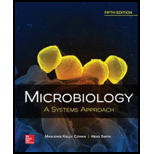
Microbiology: A Systems Approach
5th Edition
ISBN: 9781259706615
Author: Marjorie Kelly Cowan Professor
Publisher: McGraw-Hill Education
expand_more
expand_more
format_list_bulleted
Concept explainers
Textbook Question
Chapter 6, Problem 5CTQ
Use the Internet to search prion diseases, and identify three major differences between a viral disease and a prion disease.
Expert Solution & Answer
Want to see the full answer?
Check out a sample textbook solution
Students have asked these similar questions
Generate one question that requires a Punnet Squre to solve the question. Then show how you calculate the possibilities of genotype and phenotype
Briefly state the physical meaning of the electrocapillary equation (Lippman equation).
Explain in a small summary how:
What genetic information can be obtained from a Punnet square? What genetic information cannot be determined from a Punnet square?
Why might a Punnet Square be beneficial to understanding genetics/inheritance?
Chapter 6 Solutions
Microbiology: A Systems Approach
Ch. 6.1 - Describe the significance of viruses being...Ch. 6.2 - Summarize arguments on both sides of the debate...Ch. 6.2 - Identify effective terms to describe the behavior...Ch. 6.3 - Prob. 4AYPCh. 6.3 - Describe the function and structure(s) of viral...Ch. 6.3 - Distinguish between enveloped and naked viruses.Ch. 6.3 - Prob. 7AYPCh. 6.3 - Compare and contrast the composition of a viral...Ch. 6.3 - Diagram the possible nucleic acid configurations...Ch. 6.4 - Develop two arguments against assigning species...
Ch. 6.4 - Demonstrate how family and genus names in viruses...Ch. 6.5 - Diagram the six-step life cycle of animal viruses.Ch. 6.5 - Define the term cytopathic effect and provide one...Ch. 6.5 - Provide examples of persistent and transforming...Ch. 6.5 - Provide a thorough description of lysogenic and...Ch. 6.6 - List the three principal purposes for cultivating...Ch. 6.6 - Describe three ways in which viruses are...Ch. 6.7 - Prob. 18AYPCh. 6.8 - Analyze the relative importance of viruses in...Ch. 6.8 - Prob. 20AYPCh. 6 - A virus is a tiny infectious a. cell. b. living...Ch. 6 - Viruses are known to infect a. plants. b....Ch. 6 - The nucleic acid of a virus is a. DNA only. b. RNA...Ch. 6 - The general steps in a viral multiplication cycle...Ch. 6 - Prob. 5MCQCh. 6 - In general, RNA viruses multiply in the cell ____,...Ch. 6 - Viruses cannot be cultivated in/on a. tissue...Ch. 6 - Clear patches in cell cultures that indicate sites...Ch. 6 - Label the parts of this virus. Identify the...Ch. 6 - Circle the viral infections from this list:...Ch. 6 - In lysogeny, viral DNA is inserted into the host...Ch. 6 - A viral capsid is composed of subunits called...Ch. 6 - The envelope of an animal virus is derived from...Ch. 6 - The nucleic acid of animal viruses enters the cell...Ch. 6 - Viruses that persist in the (host) cell and cause...Ch. 6 - Provide evidence in support of or refuting the...Ch. 6 - Summarize the unique properties of viruses and...Ch. 6 - Prob. 3CTQCh. 6 - Compare and contrast the processes of latency and...Ch. 6 - Use the Internet to search prion diseases, and...Ch. 6 - From chapter 2, figure 2.23: A virus containing...Ch. 6 - Prob. 1CM
Knowledge Booster
Learn more about
Need a deep-dive on the concept behind this application? Look no further. Learn more about this topic, biology and related others by exploring similar questions and additional content below.Similar questions
- In a small summary write down:arrow_forwardNot part of a graded assignment, from a past midtermarrow_forwardNoggin mutation: The mouse, one of the phenotypic consequences of Noggin mutationis mispatterning of the spinal cord, in the posterior region of the mouse embryo, suchthat in the hindlimb region the more ventral fates are lost, and the dorsal Pax3 domain isexpanded. (this experiment is not in the lectures).a. Hypothesis for why: What would be your hypothesis for why the ventral fatesare lost and dorsal fates expanded? Include in your answer the words notochord,BMP, SHH and either (or both of) surface ectoderm or lateral plate mesodermarrow_forward
arrow_back_ios
SEE MORE QUESTIONS
arrow_forward_ios
Recommended textbooks for you
 Biology (MindTap Course List)BiologyISBN:9781337392938Author:Eldra Solomon, Charles Martin, Diana W. Martin, Linda R. BergPublisher:Cengage LearningSurgical Tech For Surgical Tech Pos CareHealth & NutritionISBN:9781337648868Author:AssociationPublisher:Cengage
Biology (MindTap Course List)BiologyISBN:9781337392938Author:Eldra Solomon, Charles Martin, Diana W. Martin, Linda R. BergPublisher:Cengage LearningSurgical Tech For Surgical Tech Pos CareHealth & NutritionISBN:9781337648868Author:AssociationPublisher:Cengage Biology Today and Tomorrow without Physiology (Mi...BiologyISBN:9781305117396Author:Cecie Starr, Christine Evers, Lisa StarrPublisher:Cengage Learning
Biology Today and Tomorrow without Physiology (Mi...BiologyISBN:9781305117396Author:Cecie Starr, Christine Evers, Lisa StarrPublisher:Cengage Learning Concepts of BiologyBiologyISBN:9781938168116Author:Samantha Fowler, Rebecca Roush, James WisePublisher:OpenStax College
Concepts of BiologyBiologyISBN:9781938168116Author:Samantha Fowler, Rebecca Roush, James WisePublisher:OpenStax College

Biology (MindTap Course List)
Biology
ISBN:9781337392938
Author:Eldra Solomon, Charles Martin, Diana W. Martin, Linda R. Berg
Publisher:Cengage Learning

Surgical Tech For Surgical Tech Pos Care
Health & Nutrition
ISBN:9781337648868
Author:Association
Publisher:Cengage


Biology Today and Tomorrow without Physiology (Mi...
Biology
ISBN:9781305117396
Author:Cecie Starr, Christine Evers, Lisa Starr
Publisher:Cengage Learning

Concepts of Biology
Biology
ISBN:9781938168116
Author:Samantha Fowler, Rebecca Roush, James Wise
Publisher:OpenStax College

What Is A Virus ? ; Author: Peekaboo Kidz;https://www.youtube.com/watch?v=YS7vsBgWszI;License: Standard YouTube License, CC-BY